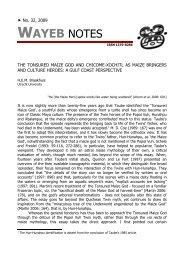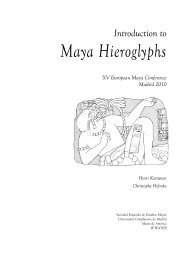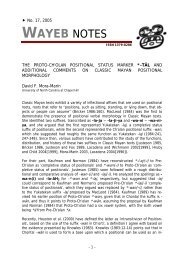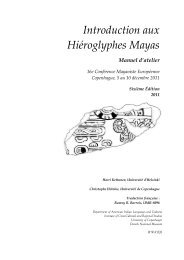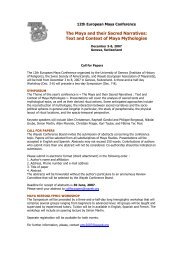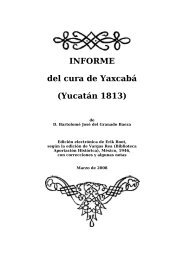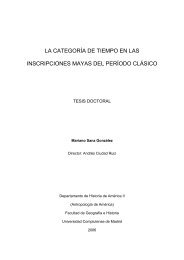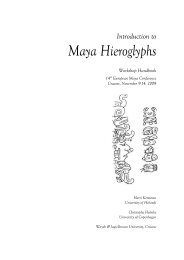Introduction to Maya Hieroglyphs - Wayeb
Introduction to Maya Hieroglyphs - Wayeb
Introduction to Maya Hieroglyphs - Wayeb
You also want an ePaper? Increase the reach of your titles
YUMPU automatically turns print PDFs into web optimized ePapers that Google loves.
Kettunen & Helmke 2011<br />
The Writing System<br />
AJAW a-AJAW-wa AJAW AJAW-wa<br />
8. SYLLABLES (SYLLABOGRAMS)<br />
The <strong>Maya</strong> writing systems uses, besides logograms, also phonetic signs in expressing syllables, or more precisely:<br />
syllabograms. These syllables can either work as CV (consonant-vowel) syllables, or C(V) sounds (the sound of the<br />
consonant without the sound of the accompanying vowel). As a rule, the last vowel<br />
wi of the last syllable in a given word drops out (and as always, there are exceptions <strong>to</strong><br />
this rule). Thus, the word for mountain, witz, can be written phonetically with two<br />
syllables, wi and tzi. Since the last vowel is discarded (due <strong>to</strong> the harmony<br />
tzi principles), the word reads wi-tz(i) > witz.<br />
9. PHONETIC COMPLEMENTS<br />
A phonetic complement is a sign that “helps” the reading of the logogram. It is a pronunciation “assistant” in<br />
cases when the main sign has more than one possible reading. Phonetic complements are very common in the<br />
<strong>Maya</strong> script, and they have also played a major role in the modern decipherment of the <strong>Maya</strong> writing system.<br />
Phonetic complements, which cued ancient <strong>Maya</strong> readers, also cue modern readers thereby facilitating the<br />
reading of ambivalent logographic signs.<br />
In the following example, the syllable wi (shaded sign) works as a phonetic complement for the logogram WITZ.<br />
The presence of the prefixed syllable wi- therefore informs us that the word represented by the logogram also<br />
begins with the phonetic value wi-...<br />
wi-WITZ<br />
witz<br />
“mountain”<br />
In the example below, the syllabogram ki (shaded sign) is attached <strong>to</strong> the zoomorphic logogram <strong>to</strong> provide the<br />
final sound …-k of the word Chahk (or Chaak) <strong>to</strong> distinguish it from a another reading of a similar head in the<br />
word Kalomte’.<br />
CHAK-ki<br />
Chahk / Chaak<br />
Name of a deity<br />
KAL-TE’<br />
Kalomte’ / Kaloomte’<br />
Exalted royal title<br />
19/154



